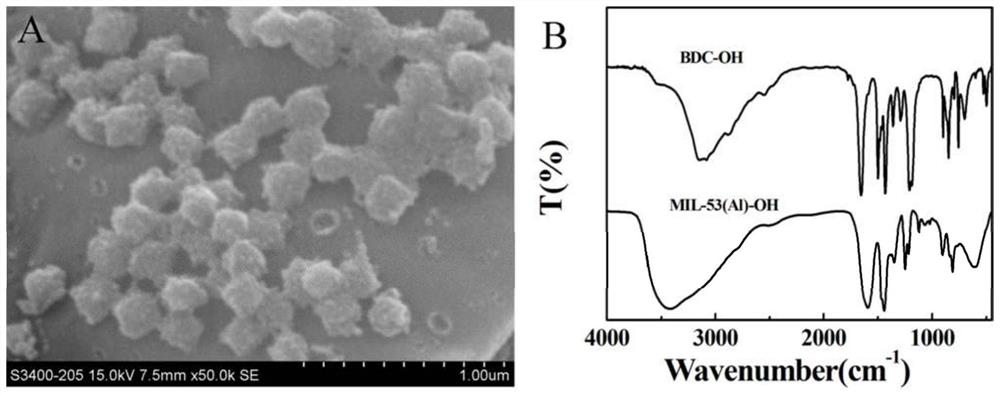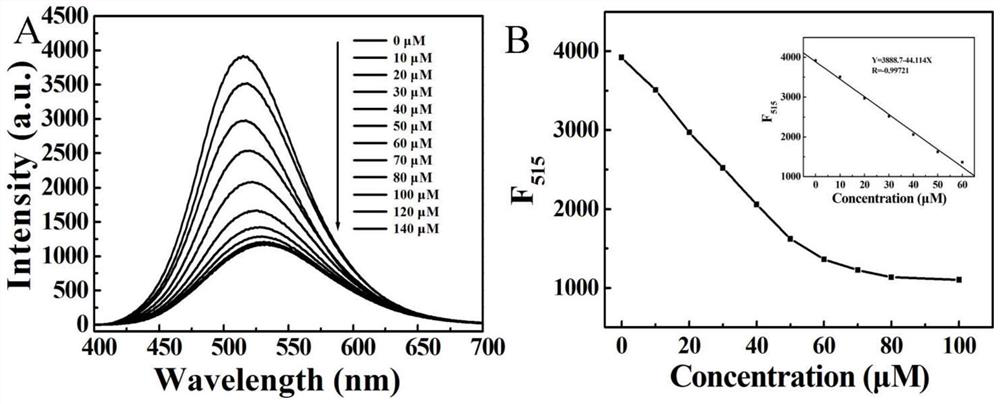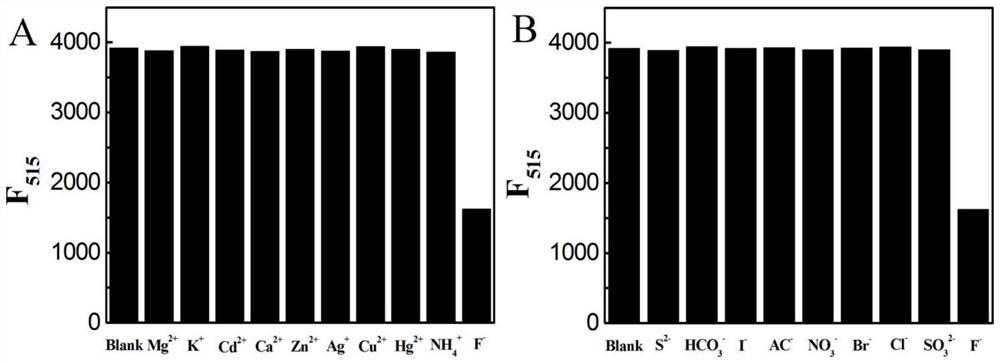Preparation method of hydroxyl modified metal organic framework material fluorescent probe, and fluoride detection application of fluorescent probe
A metal-organic framework and fluorescent probe technology, applied in the field of fluorescence sensing, can solve problems such as limiting practical applications, and achieve the effects of good stability, cheap and easily available raw materials, and good selectivity.
- Summary
- Abstract
- Description
- Claims
- Application Information
AI Technical Summary
Problems solved by technology
Method used
Image
Examples
Embodiment 1
[0025] Preparation of fluorescent probe MIL-53(Al)-OH-Tris: Add 3 mL of 76 mM 2,5-dihydroxyterephthalic acid in DMF to 3 mL of 50 mM aluminum nitrate hexahydrate in DMF, and ultrasonicate at room temperature for 5 The mixed solution was obtained in 1 minute; the mixed solution was sealed in a polytetrafluoroethylene lined autoclave, heated in a 130°C oven for 8 hours, then naturally cooled to room temperature; centrifuged for 5min at a speed of 10000rpm, and the yellow precipitate ( The yellow precipitate is a hydroxyl-modified metal-organic framework nanomaterial), and the yellow precipitate is alternately washed twice with DMF and ethanol; finally, the yellow precipitate is dispersed in 10 mL of 50 mM Tris-HCl buffer solution with pH=4 to obtain MIL-53(Al)- OH-Tris probe solution.
[0026] The morphology of MIL-53(Al)-OH nanomaterials was characterized by scanning electron microscopy, figure 1 A shows that MIL-53(Al)-OH is spherical in shape with a particle size of about 15...
Embodiment 2
[0028] Fluorescent probe MIL-53(Al)-OH-Tris to detect fluoride ions: mix 500 μL MIL-53(Al)-OH-Tris probe solution and 500 μL sodium fluoride standard solution of different concentrations, incubate at room temperature for 30 minutes, Under the excitation wavelength of 365nm, the fluorescence emission peak of the fluorescent probe MIL-53(Al)-OH-Tris at 515nm decreases with the increase of the concentration of sodium fluoride, and the change rate of the fluorescence intensity has a linear relationship with the concentration of sodium fluoride. Fluorescence emission peak (F 515 ) has a good linear relationship with the increase of fluoride ion concentration, and the detection limit is 0.3 μM when the signal-to-noise ratio is 3 ( figure 2 ).
Embodiment 3
[0030] Investigate the selectivity of fluorescent probe MIL-53(Al)-OH-Tris to detect fluoride ions: in the selectivity test, 50 μ M NaX solution (X=S 2- ,I - , Cl - , AC - ,Br - ,NO 3 - , HCO 3 - , SO 3 2- ) and 50 μM MCl solution (M=K + ,NH 4 + ,Mg 2+ ,Cu 2+ ,Zn 2+ ,Cd 2+ , Ca 2+ ,Hg 2+ , Ag + ) into the MIL-53 (Al)-OH-Tris probe solution respectively, and measure the fluorescence emission spectrum of the MIL-53 (Al)-OH-Tris probe in each interference ion under the same conditions as in Example 2 Figure, the measurement results are as image 3 shown. The results show that the fluorescence intensity of the MIL-53(Al)-OH-Tris probe solution is not interfered by the above-mentioned ions, and only the fluoride ion can effectively quench the fluorescence of the MIL-53(Al)-OH-Tris, which is the structure of the present invention. The fluorescent probe MIL-53(Al)-OH-Tris with hydroxyl modified metal-organic framework nanomaterials has good selectivity for detect...
PUM
 Login to View More
Login to View More Abstract
Description
Claims
Application Information
 Login to View More
Login to View More - R&D
- Intellectual Property
- Life Sciences
- Materials
- Tech Scout
- Unparalleled Data Quality
- Higher Quality Content
- 60% Fewer Hallucinations
Browse by: Latest US Patents, China's latest patents, Technical Efficacy Thesaurus, Application Domain, Technology Topic, Popular Technical Reports.
© 2025 PatSnap. All rights reserved.Legal|Privacy policy|Modern Slavery Act Transparency Statement|Sitemap|About US| Contact US: help@patsnap.com



